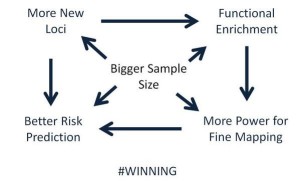
For Today's Comic Relief
Peter Kraft, ‘Professor, Harvard School of Public Health - Deputy Director, Program in Molecular and Genetic Epidemiology’, wrote -



How is this for other reason for proposing more and larger GWAS for ‘more complex traits’ - ‘my salary depends on it’?
-————————————————
What do the scientists say, when their salaries do not depend on proposing ‘big science’?
1. Bernard S. Strauss, who retired.
Mutation and Cancer A View from Retirement
2. Dan Graur, who “has a very low threshold for hooey, hype, hypocrisy, postmodernism, bad statistics, ignorance of population genetics and evolutionary biology masquerading as -omics, and hatred of any kind” -
Creativity & Anarchy: Big Science as an Antonym of Science
3. Ken Weiss, Evan Pugh Professor Emeritus at Penn State, has an entire blog dedicated to the topic. He wrote a book titled Genetic Variation and Human Disease: Principles and Evolutionary Approaches in 1993, and has been arguing against large GWAS studies since 2000, when he wrote a Nature paper titled - “How many diseases does it take to map a gene with SNPs?” We discussed it in the following blog post, and an extract from his paper is posted below.
Battle over #GWAS: Ken Weiss Edition
We do not contest that genome scanning for LD can work when there is a strong difference in the frequency of some risk genotype(s) between cases and controls. Nikali et al. were able to map the gene responsible for a rare recessive ataxia in a Finnish cohort using an LD-based genome scan with microsatellite markers using only four affected individuals, demonstrating that it can, of course, work. Similarly, the poster boy of the SNP proponents wears a T-shirt advertising APOE ?4 and Alzheimer disease; this association is cited as proof-of-principle for SNP-based association mapping. By using a data set in which APOE ?4 was known to be over-represented in cases compared with controls, it has been possible to take a set of SNPs that are in LD with the risk allele and identify the association without studying APOE ?4 itself. This case, stacked in favour of positive ?ndings, shows that neither coding SNPs, nor most SNPs, nor common SNPs, nor nearby SNPs, nor single SNPs, nor a SNP in a neighbouring gene, nor even simple haplotypes can be relied upon, a priori, as a single, casually designed source of LD markers. What this does show is the not-surprising fact that when there is an association with a single risk allele, one can identify this by using multiple markers which are in LD with this single risk allele14. How easily would genes such as BRCA1, BRCA2, PSEN1, PSEN2 and ABCA4, which have many alleles each of which increases risk of some common disease, be mapped by scrutinizing a set of common SNPs in a sample from a large cosmopolitan population13,14? No one can deny that disease pathways have been identi?ed by genetic epidemiology studies, making contributions to our biological knowledge. So far, however, it is lifestyle changes that have made the most impact on reduced (or increased!) incidence of chronic disease. In those instances in which common variants affecting common disease really do exist, it is important to ?nd them. But we regularly hear grander promises, and it is at least fair to ask whether scaling up current genetic approaches, which have been likened to a search for a needle in a needle stack (a great many individually modest, effects), would be the wisest investment when a major justi?cation is that nothing else has worked so far.
To some this is an inapt question. New genes may identify previously unknown biochemical pathways that may lead to therapeutic pharmaceutical improvements (even if the latter are not speci?cally genetic). Other investigators argue that the identi?cation of even weakly predictive screening tools is suf?cient justi?cation, or hope that a worthwhile fraction of complex diseases will have common variants with individually modest effect but substantial attributable risk. The level of merit in these arguments is dif?cult to evaluate, and the track record is unclear at best; but the arguments undeniably have aspects of rationalizing results that are not living up to expectations, sometimes based on unrealistically optimistic models, and sometimes dominated by wishful thinking. At the least, we should undertake the effort to assess the underlying assertions?including of course those that we advance here?about the degree to which common alleles with usefully important effects exist for chronic disease; such asssessment should use focused and systematic approaches that take the biological realities seriously.
We know these views run against momentum and heavily vested interests. Those interests are promoted by reference to their successes (sometimes overstated, and often argued ?rstor onlythrough the business or journalistic press rather than peer-reviewed articles4). We expect criticism from such quarters, but readers should be aware of the less-publicized failures and inef?ciencies. What per cent of complex disease gene-mapping projects whose grant proposals promised 80% power have actually been successful in identifying the disease genes assumed to be in the data? Application of most current mapping strategies could arguably be more effective if focused on traits that clearly have a genetic basis, such as frank paediatric disorders (which represent a human version of mouse knockouts, where one can assess the effects of the complete absence of a gene product), or on candidate genes, where the genetic or population payoff might be higher, or subsets of complex disease, in samples from appropriately chosen populations where LD may be high and aetiology more marked and homogeneous (or perhaps most importantly through reductions in environmental heterogeneity). Even if such traits are individually rare, they are numerous, and we know genetic methods work to unravel their aetiologies.
Resistance to genetic reductionism is not new, and we know that, by expressing these views (some might describe them as heresies), we risk being seen as stereotypic nay-sayers. However, ours is not an argument against genetics, but for a revised genetics that interfaces more intimately with biology. Biological traits have evolved by noise-tolerant evolutionary mechanisms, and a trait that doesnt manifest until long after the reproductive lifespan of most humans throughout history is unlikely to be genetic in the traditional, deterministic sense of the term. Most genetic studies that focus on humans are designed, in effect, to mimic Mendels choice of experimental system, with only two or three frequent states with strongly different effects. That certainly enables us to characterize some of the high-penetrance tail of distribution of the allelic effects, but as noted above these may usually be rather rare. But in?ated claims based on this approach can divert attention from the critical issue of how to deal with complexity on its own terms, and fuel false hopes for simple answers to complex questions. The problems faced in treating complex diseases as if they were Mendels peas show, without invoking the term in its faddish sense, that complexity is a subject that needs its own operating framework, a new twenty-?rst rather than nineteenth?or even twentieth?century genetics.